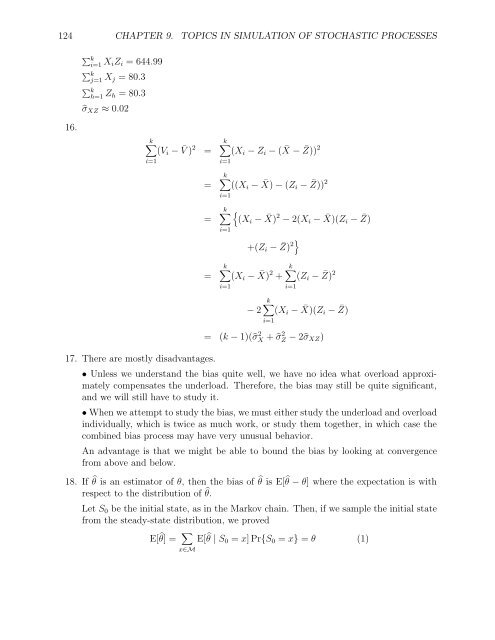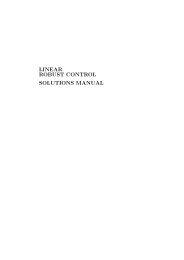SOLUTIONS MANUAL for Stochastic Modeling: Analysis and ...
SOLUTIONS MANUAL for Stochastic Modeling: Analysis and ...
SOLUTIONS MANUAL for Stochastic Modeling: Analysis and ...
You also want an ePaper? Increase the reach of your titles
YUMPU automatically turns print PDFs into web optimized ePapers that Google loves.
124 CHAPTER 9. TOPICS IN SIMULATION OF STOCHASTIC PROCESSES<br />
∑ ki=1<br />
X i Z i = 644.99<br />
∑ kj=1<br />
X j =80.3<br />
∑ kh=1<br />
Z h =80.3<br />
̂σ XZ ≈ 0.02<br />
16.<br />
k∑<br />
(V i − ¯V ) 2 =<br />
i=1<br />
=<br />
=<br />
=<br />
k∑<br />
(X i − Z i − ( ¯X − ¯Z)) 2<br />
i=1<br />
k∑<br />
((X i − ¯X) − (Z i − ¯Z)) 2<br />
i=1<br />
k∑ {<br />
(Xi − ¯X) 2 − 2(X i − ¯X)(Z i − ¯Z)<br />
i=1<br />
+(Z i − ¯Z)<br />
2}<br />
k∑<br />
(X i − ¯X)<br />
k∑<br />
2 + (Z i − ¯Z) 2<br />
i=1<br />
i=1<br />
k∑<br />
− 2 (X i − ¯X)(Z i − ¯Z)<br />
i=1<br />
= (k − 1)(̂σ X 2 + ̂σ Z 2 − 2̂σ XZ )<br />
17. There are mostly disadvantages.<br />
• Unless we underst<strong>and</strong> the bias quite well, we have no idea what overload approximately<br />
compensates the underload. There<strong>for</strong>e, the bias may still be quite significant,<br />
<strong>and</strong> we will still have to study it.<br />
• When we attempt to study the bias, we must either study the underload <strong>and</strong> overload<br />
individually, which is twice as much work, or study them together, in which case the<br />
combined bias process may have very unusual behavior.<br />
An advantage is that we might be able to bound the bias by looking at convergence<br />
from above <strong>and</strong> below.<br />
18. If ̂θ is an estimator of θ, then the bias of ̂θ is E[̂θ − θ] where the expectation is with<br />
respect to the distribution of ̂θ.<br />
Let S 0 be the initial state, as in the Markov chain. Then, if we sample the initial state<br />
from the steady-state distribution, we proved<br />
E[̂θ] = ∑<br />
E[̂θ | S 0 = x]Pr{S 0 = x} = θ (1)<br />
x∈M















